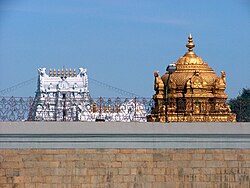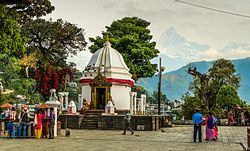Unlike some other religions, Hindus are not required to undertake pilgrimages during their lifetime. [1] However, most Hindus go on such journeys to numerous iconic sites including those below: [2]
| Part of a series on |
| Hinduism |
|---|
 |
Unlike some other religions, Hindus are not required to undertake pilgrimages during their lifetime. [1] However, most Hindus go on such journeys to numerous iconic sites including those below: [2]





Char Dham (Famous Four Pilgrimage sites): The four holy sites Puri, Rameswaram, Dwarka, and Badrinath (or alternatively the Himalayan towns of Badrinath, Kedarnath, Gangotri, and Yamunotri) compose the Chota Char Dham (four small abodes) pilgrimage circuit.
Kumbh Mela: The Kumbh Mela (the "pitcher festival") is one of the holiest of Hindu pilgrimages that is held every three years; the location is rotated among Prayagraj, Haridwar, Nashik, and Ujjain.
Old Holy cities as per Puranic Texts: Varanasi formerly known as Kashi, Prayagraj also known as Prayag, Haridwar-Rishikesh, Mathura-Vrindavan, Kurukshetra, the Land of Bhagavad Gita in Haryana and Ayodhya.
Old Temple cities: Puri, which hosts a major Vaishnava Jagannath temple and Rath Yatra celebration; Katra, home to the Vaishno Devi temple; Tirumala – Tirupati, home to the Tirumala Venkateswara Temple; Shirdi, home to the Sai Baba of Shirdi temple; Madurai Meenakshi and Sri Ranganathaswamy Temple in Sri Rangam; Dwarkadhish Temple – Dwarka, home to Dwarkadhish form of Sri Krishna; Radharani Temple – Barsana, dedicated to Sri Radha, Sabarimala, where Swami Ayyappan is worshipped; Sri Padmanabhaswamy Temple at Thiruvananthapuram, Kerala; Guruvayur temple at Guruvayur. The oldest of these temple pilgrimages is the Pandharpur Wari which is said to be in tradition from the past 800 years.
New Pilgrimage Centres: Three comparatively recent temples of fame and huge pilgrimage are Belur Math, the hub of the worldwide Ramakrishna Movement in West Bengal, Dakshineswar Kali Temple, Kolkata West Bengal;Tarapith West Bengal, Vivekananda Rock Memorial at Kanyakumari; Sri Ramana Ashram at Tiruvannamalai; and ISKCON temples in Ujjain, Bangalore, [3] Patna, Tirumala, Vishakapatnam, Delhi, Chennai, and Mumbai. Ramakrishna Mission Swami Vivekananda's Ancestral House and Cultural Centre, the birthplace of Swami Vivekananda is also another popular destination. Nandikeshwari Temple West Bengal,Kankalitala, Kiriteswari Temple, Nabadwip, Mayapur,
Shakti Pitha: An important set of pilgrimages are the Shakti Pitha , where the Mother Goddess is worshipped, the three principal ones being Kalighat, Tarapith and Kamakhya .
Jyotirlingas: Other set of important pilgrimages are the Jyotirlingas , where lord Shiva is worshipped in the form of Shiva Lingas. There are twelve Jyotirlingas in India. The twelve Jyotirlingas are:
These Hindu pilgrimage sites are only located on the main island country and not on the other regrouped islands under the Republic of Mauritius.















